A few years ago, while climbing at Mickey’s Beach, a coastal crag just outside San Francisco, Eliot Carlsen lost his grip and fell. He was halfway up Sex Porpoises, a popular 5.12c sport route that absorbs an almost constant salty spray from the Pacific, but he was roped up and thus left dangling 35 feet above the ground. He collected himself and started climbing an adjacent route called Squid Vicious (5.13a) back toward where he fell. Still connected to Sex Porpoises, Carlsen clipped a quick draw onto one of the Squid Vicious bolts to pull himself back up, but the moment he tugged on the rope the bolt pulled out of the rock.��
Carlsen peered down at the jagged ground below. “If someone were to have been climbing on Squid Vicious that day or the next week, they would’ve gotten hurt,” Carlsen says. “They would’ve crashed into the rocks probably. It would not have been pretty.”��
Afterwards, Carlsen, a 34-year-old manager at climbing gym in San Francisco, phoned the man who first lead��the route in 1994, and who placed the bolt ten years earlier: Jim Thornburg. But he wasn’t calling to talk about its initial placement; he was calling to talk about its replacement. Thornburg, a 51-year-old photographer and lifelong Bay Area climber, has spent the past five years rebolting many of the most popular routes along the Northern California coast, at Mickey’s as well as Fisk Mill Cove and Dry Creek sea crags. The titanium and high-grade stainless-steel glue-in bolts Thornburg uses have revolutionized the rebolting process in coastal regions around the world, from the Bay Area to Greece to Thailand.
Rebolting is nothing new in climbing. A bulk of sport routes in the U.S. were put up in the late 1980s and 1990s and need maintenance from time to time. Bolts on inland climbing routes typically wear down over decades, and sometimes corrode. But routes near the ocean present a unique problem: the combination of salt and moisture accelerates deterioration of traditional stainless steel bolts. “With the number of years that have passed since these bolts first went in,” Carlsen says, “we’re getting to that critical juncture where they’re starting to corrode and get bad.”
“With the number of years that have passed since these bolts first went in,”��Carlsen��says, “we’re getting to that critical juncture where they’re starting to corrode and get bad.”
Soon after Thornburg and others first came to realize that the original 304 grade stainless steel bolts they placed at Mickey’s Beach in the 1980s were inadequate, they replaced them with 316 grade steel in the early 1990s. (316 steel resists rust better in marine environments than��304 steel, but its lifespan��is just as unpredictable.) A handful of the new bolts failed within a decade, but what alarmed Thornburg was the fact that most showed no sign of weakness on the outside. The likely cause? Stress corrosion cracking (SCC), wherein��microscopic cracks in traditional steel wedge bolts expand due to moist, salty air infiltrating the hole in the rock. Eventually, the bolt��rots.��
After the first replacements were put in, a��friend of Thornburg’s ordered a batch of custom-made 316 grade U bolts that Thornburg��could epoxy��into the rock. Thornburg and three climbing buddies installed 50 glue-in bolts, which have now lasted 25 years without fail. Over the past five years, Thornburg and a handful of younger climbers he recruited to help—Steven Roth, Casey Zak, Dave Stallard, and Conrad Frausto—have put in ten-to-12-hour days replacing 200 additional bolts across Northern California. The process is��arduous: drill a five-inch hole in the rock; brush with a metal pipe cleaner; blow out the dust; repeat the last two steps; insert the bolt and glue it in tight.
“I’d be completely destroyed at the end of those days,” Thornburg says. “My least favorite part was the smell. I’m a Berkeley healthfood nut, so dealing with that toxic glue all day was terrible.”
Thornburg funded much of the recent rebolting work himself, but the unique challenges presented by coastal corrosion worldwide have more financial support than ever. In Greece, where Kalymnos island’s 2,700 bolted routes attract some 10,000 climbers each year, 52-year-old Aris Theodoropoulos is leading an effort to rebolt ten percent of the routes, or roughly 3,000 bolts. The European Union recently earmarked 150,000 Euros to pay for the bolts, thus protecting the country’s tourism interests. Theodoropoulos, a guidebook author who paid for early rebolting efforts with money he made from book sales, was only able to use about 50,000 of the EU’s allotted Euros due to bureaucracy costs, he says, but the benefit remains: “They’re helping us to have safer crags.”
In Thailand, which uses more glue-in titanium bolts for rebolting than anywhere in the world, the (ASCA) supplies bolts for a local organization called the Thaitanium Project to install. (Titanium is virtually immune to the corrosive effects of sea air and saltwater, both in general and in crevices, but is much more expensive.) ASCA director Greg Barnes estimates his organization has sent more than 3,000 bolts to Thailand over the years, as well as contributed roughly 110 steel and titanium bolts, plus glue, to the Northern California rebolting effort.
Regardless of what kind of metal is used, epoxy remains the key ingredient, transforming coastal crags from mine fields back to trustworthy sites. “I would never put a bolt near the ocean that wasn’t a glue-in bolt again,” Thornburg says.


